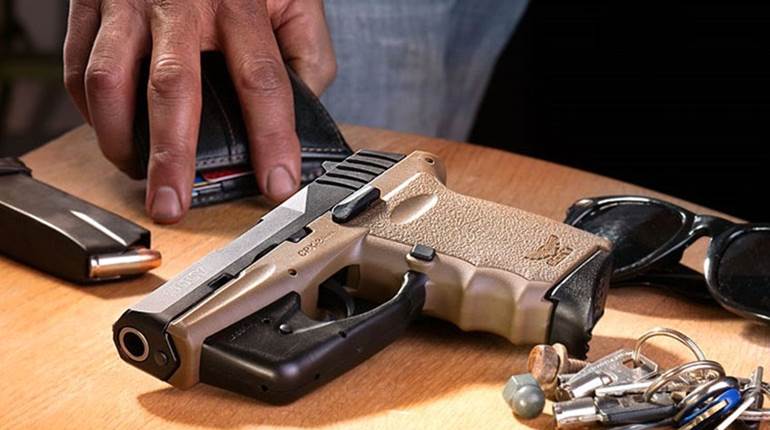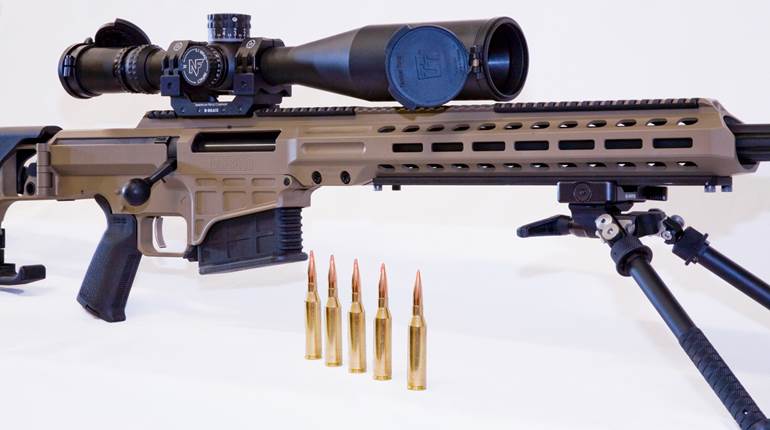
A host of companies make semi-automatic AR-15-style rifles nowadays, and although many have copied the original military pattern family of rifles, few have actually taken the nearly 50-year-old design to new places. Not only do some of these firms design and manufacture complete guns, some also make excellent accessories that have seen service with our most elite soldiers and sailors. Karl Lewis of Lewis Machine & Tool (LMT) has done just that.
Lewis formed LMT in 1980 in Milan, Ill. The original mission of the company was to manufacture firearm components. In 1986 Lewis began building complete rifles primarily for military and law enforcement for overseas sales. LMT now makes individual components, subassemblies and major assemblies for large-, medium- and small-caliber systems for the U.S. government. LMT also does a good amount of original equipment manufacturer (OEM) work for high-end AR-15/M4 makers seeking to build rifles to customer-supplied specifications.
While working on the book Black Rifle II, I heard of LMT’s removable-barrel Monolithic Rail Platform (MRP) with its integrated receiver/fore-end that is machined from a single 7075-T6 aircraft-grade aluminum forging. I felt that the design, which was introduced in 2004, represented a significant leap in the evolution of the AR platform—if it worked. So, I contacted Karl Lewis, and he immediately shipped me carbine- and standard-length MRPs, available only in direct-gas impingement at that time, along with four barrels.
Barrels could be switched by removing two Torx head screws. I placed the carbine-length model on a full-automatic Colt M4 lower receiver and fired more than 300 rounds each through the 10.5-, 14.5- and 16-inch barrels—much of which was on full automatic—with no malfunctions. In addition to the barrels chambered in 5.56x45 mm NATO, LMT included one chambered for the .499 Leitner Wise, which at that time was being considered by the U.S. Coast Guard.
Last year, I contacted Lewis to request current-production rifles in both direct gas-impingement and piston operation for testing and evaluation. Both were on semi-automatic-only LMT Defender lower receivers, although the piston-operated rifle used an H2 buffer instead of a standard carbine buffer to prevent bolt carrier bounce and light primer strikes in burst fire. As of this writing the MRP offers chamberings in .204 Ruger., 5.56x45 mm NATO, 6.8x43 mm SPC and .308 Win., although others may follow.
Direct-Gas-Impingement MRPs
LMT offers two versions of the direct-gas MRP: the CQB MRP, which is intended for carbine-length barrels, and the standard MRP, which is intended for 18- to 20-inch barrels. I received the CQB MRP (CQB16) with 10.5-, 14.5- and 16-inch barrels for testing.
The barrels had chrome-lined bores, and all had been proof-fired and magnetic-particle inspected to ensure they were free from stress fractures. LMT is no stranger to government testing requirements and protocols. Before a barrel is accepted for the MRP it must fire a 1.5-inch mean spread with lead-core bullets (not M855). Barrels come preassembled with gas blocks and tubes, making removal and replacement a modular affair.
The bolt carrier group on the direct gas-impingement carbine is an exclusive LMT feature. The carrier was re-engineered as an enhancement to the M4 to be tested by SOCOM. It has many changes from the standard bolt carrier, including five gas exhaust ports instead of three. The most important change is in the cam track, which has been altered so there is more dwell time before the bolt unlocks on the 14.5-inch M4 barrel. This slows the opening stroke, allowing pressure to drop inside the cartridge case, aiding extraction reliability and decreasing wear on the bolt. Also, four grooves placed on the bottom of the carrier aid reliability in harsh environments. The interior and carrier key were chrome-plated.
The redesigned bolt is of a stronger proprietary material (LMT wouldn’t divulge its composition), making it more difficult and expensive to manufacture. All bolts, whether enhanced or standard, are manufactured by LMT and are proof-tested and magnetic-particle-inspected. The lugs have relief cuts designed to allow them to better distribute the force that acts upon them during firing. The extractor, too, has been completely redesigned. A significantly more aggressive extractor claw, backed by two springs, grips the rim of the cartridge case.
The upper receiver incorporates a forward assist as well as a case deflector. The quad rails are marked to aid in placing the optics or accessories back on the same spot. All the barrels tested had the G.I. 1:7-inch twist rate with an A2-style compensator.
The upper and lower receivers fit together nicely with little to no movement. The selector settings were clearly visible and highlighted on both the left and right sides. The rifle came with three TangoDown rail protectors on it. Also included was a torque wrench that permitted the required 140 in.-lbs. on the two bolts that hold the barrel into the upper receiver.
For testing, a Trijicon 4X 20 mm ACOG sight was added and Magpul PMags were used. I used Silver State Armory 5.56x45 mm NATO 55-grain full-metal jacket (FMJ) ammunition for function testing. This comprised of 300 rounds of both slow and rapid fire. No malfunctions were encountered. After the barrel was broken-in, Silver State Armory 5.56x45 mm NATO 77-grain open-tip match (OTM) ammunition was used for accuracy testing, along with Black Hills Mk 262 Mod 0 77-grain OTM ammunition. The first five-shot group measured approximately 1.5 inches at 100 yards with the Black Hills load. The Silver State Armory ammunition produced nearly identical results. These are respectable groups from any military-type barrel. Perhaps with a higher magnification scope, the groups may have been tighter, but it seemed more realistic to fire the rifle with a combat optic.
Piston-Driven MRPs
In the past few years, several companies have come to market with gas-piston-operated AR-style rifles. While the debate goes on as to which system is better, a niche has been created. Some believe the reduction in heat transfer into the bolt carrier from propellant gas, hence less fouling, is an advantage of piston systems over direct gas-impingement. When Karl Lewis was asked why he introduced a piston-operated design, his answer was quick and to the point: “customer demand.” With his already proven MRP technology, it only made sense to base it on that platform.
The bolt carrier had to be modified for the use of a piston, and this has been done many different ways throughout the industry. LMT’s bolt carrier, including the impact surface for the piston operating rod, is machined out of a single piece of metal. To prevent damage to the receiver extension, “skis” were added to the bottom of the rear of the bolt carrier. As the carrier is tipped downward from the impact of the piston the skis straighten the carrier out, preventing damage from initial impact. LMT uses a standard AR-15-type bolt, although the gas rings are omitted. The bolt carrier group utilizes a proprietary LMT coating, which is harder and more wear-resistant than conventional coatings.
The piston system is simple and reliable. The operating rod/piston and gas plug are part of the barrel assembly just as the gas tube is on the direct-gas MRP; however, the operating rod/piston and gas plug can be removed without detaching the barrel for cleaning. By depressing a spring-loaded detent and rotating the gas plug counterclockwise, the gas plug, piston/operating system can be withdrawn for cleaning and maintenance. There are two gas rings on the end of the piston to prevent gas loss.
I tested the piston-driven MRP with a chrome-plated and manganese-phosphate finished 16.1-inch barrel with semi-automatic bolt carrier, as well as a full-automatic carrier provided for use with a 12-inch barrel. To test the piston-operated MRP, I used 300 rounds of Silver State Armory 5.56x45 mm NATO ammunition. Most was fired on full-automatic. No malfunctions were encountered. I tested the same 4X 20 mm ACOG with both Silver State Armory as well as Black Hills 77-grain OTM ammunition. This particular rifle grouped the Silver State Armory ammunition slightly better. Groups measured just less than 1.75 inches at 100 yards. The Black Hills average was slightly more than 2 inches.
LMT’s MRP Accessories
Both direct-gas and piston-operated LMT rifles feature numerous proprietary accessories, including a six-position SOPMOD stock, which is used as part of the SOPMOD kit as well as on all Navy Mk 18 Mod 0 CQB rifles. Dual battery storage compartments and a smooth triangular shape give the stock a comfortable cheekweld when shooting. A removable rubber buttpad wraps around the buttplate, and two fittings accept QD sling adapters. The SOPMOD stock is tight on the receiver extension to help eliminate wobble. The pistol grip is the comfortable Ergo Grip, which has found great acceptance with the SOCOM Mk 12 Special Purpose Rifles. The guns also included ambidextrous selector levers, which is a great enhancement for left-handed shooters but is useful under some circumstances for right-handed shooters as well.
The upper receivers are equipped with the LMT back-up iron sights (BUIS), which are also standard-equipment on the Navy Mk 18 Mod 0. The rear sights are fully adjustable for windage and elevation, and features dual apertures for both short- and long-range shooting, while the front sights have the traditional triangular shape and are removable. The charging handles have enlarged latches that proved easy to grasp.
My overall impression of the LMT MRP system was outstanding. Being able to change out barrels not only for length, but also for caliber, and change over the operating system with the turn of two screws is amazing. The fit and finish of the rifles were top-rate, and there was little difference in feel between the impingement and the piston-operated rifles.
With its quality of manufacturing, variety of chamberings and unique design, the LMT MRP takes the aging AR platform into another realm.






































